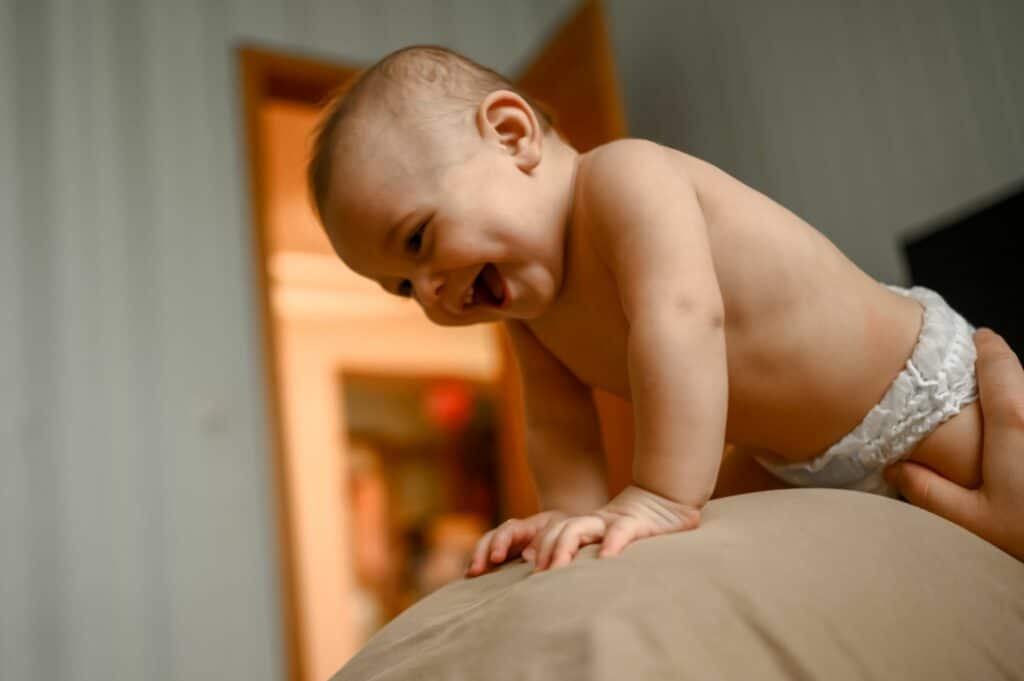Babies have a variety of self-soothing behaviors, and one of them is humping themselves to sleep. This behavior can be concerning for parents who may not understand why their baby is doing it. However, it is a normal and healthy behavior that helps babies regulate their emotions and calm down before falling asleep.
Understanding self-soothing behaviors is crucial for caregivers who want to provide the best care for their baby. Humping is a self-soothing behavior that babies use to regulate their nervous system and relieve stress. By humping themselves, babies are creating a rhythmical movement that helps them relax and feel more secure. This behavior is especially common in babies who are tired or overstimulated and need to wind down before falling asleep.
The science behind sleep and soothing is complex, but it is clear that self-soothing behaviors like humping are an essential part of a baby’s sleep routine. By allowing babies to engage in these behaviors, caregivers can help them develop healthy sleep habits and promote emotional regulation. It is also important for caregivers to understand common concerns and misconceptions about humping so that they can provide practical guidance and support for their baby’s development.
Key Takeaways
- Humping is a normal and healthy self-soothing behavior that babies use to regulate their emotions and calm down before falling asleep.
- Understanding self-soothing behaviors is crucial for caregivers who want to provide the best care for their baby.
- By allowing babies to engage in self-soothing behaviors like humping, caregivers can help them develop healthy sleep habits and promote emotional regulation.
Understanding Self-Soothing Behaviors
Self-soothing behaviors are common among babies and young children. These behaviors are a way for children to calm themselves down and relax. Some examples of self-soothing behaviors include sucking on fingers, rubbing a comfort object, and rhythmic movements such as rocking or humping.
Normal Developmental Milestones
Self-soothing behaviors, including humping, are normal developmental milestones for babies. According to New Mamaa, it is common for babies to start humming themselves to sleep around 4-6 months of age. This is typically when they begin to develop more self-soothing behaviors and gain more control over their vocalizations.
The Role of Self-Comfort
Self-soothing behaviors play an important role in helping babies and young children feel comfortable and secure. When a baby humps themselves to sleep, they are engaging in a self-comforting behavior that helps them relax and fall asleep. This behavior can also help toddlers manage stress and induce sleep, according to Sleep Baby.
It is important to note that self-soothing behaviors, including humping, are typically not a cause for concern unless they interfere with a child’s daily activities or continue beyond the early childhood years. If a child’s self-soothing behavior is causing problems, parents may want to consult a pediatrician or child development specialist for guidance.
In summary, self-soothing behaviors are a normal part of development for babies and young children. Humping is one of many self-soothing behaviors that can help children feel comfortable and secure. If parents have concerns about their child’s self-soothing behavior, they should consult a professional for guidance.
The Science Behind Sleep and Soothing
Babies hump themselves to sleep for several reasons, including self-soothing, comfort, and relaxation. Understanding the science behind sleep and soothing can help parents create a conducive environment for their baby’s sleep. This section explores sleep associations and comfort objects, physical movements, and sleep quality.
Sleep Associations and Comfort Objects
Sleep associations are habits or objects that a baby associates with sleep. Comfort objects, such as blankets or stuffed animals, can provide a sense of security and comfort to babies. According to a study by the American Academy of Pediatrics, “the presence of a comfort object may facilitate the transition from parent-provided to self-soothing sleep.” source
A consistent bedtime routine that includes a comfort object can help babies develop positive sleep associations. Parents can also use white noise machines to create a calming sleep environment and promote restful sleep.
Physical Movements and Sleep Quality
Physical movements, such as humping, rocking, or bouncing, can help babies soothe themselves to sleep. These movements create a sense of rhythm that can mimic the movement of the womb. According to a study by the National Sleep Foundation, “gentle rhythmic movements can help soothe babies and improve the quality of their sleep.” source
Breathing exercises can also help babies relax and fall asleep. Slow, deep breathing can lower heart rate and promote relaxation. Parents can incorporate breathing exercises into their baby’s bedtime routine by holding their baby close and taking deep breaths together.
In conclusion, understanding the science behind sleep and soothing can help parents create a conducive environment for their baby’s sleep. By incorporating sleep associations, comfort objects, physical movements, and breathing exercises into their baby’s bedtime routine, parents can promote restful sleep and help their baby develop positive sleep associations.
Common Concerns and Misconceptions
Distinguishing Between Normal and Problematic Behavior
It is natural for caregivers to feel anxious or embarrassed when they observe their baby humping objects or themselves. However, it is important to distinguish between normal and problematic behavior. According to Parental Questions, babies engage in self-soothing behaviors before falling asleep. This can include sucking their thumb, snuggling with a favorite toy, or humping themselves or objects. These behaviors are normal and should not cause concern.
However, if the behavior is excessive or causes harm, it may be problematic. Caregivers should monitor the behavior and intervene if necessary. According to Coping with Lindsey, humping behavior can be problematic if it is aggressive or causes physical harm, such as bruising or bleeding. If the behavior is excessive or causes harm, caregivers should seek professional advice.
Addressing Caregiver Anxiety and Shame
Caregivers may feel embarrassed or ashamed when they observe their baby humping objects or themselves. However, it is important to remember that this behavior is normal and common. According to New Mamaa, babies have a natural instinct to self-soothe before falling asleep. Humping is a way for them to pacify themselves.
Caregivers can address their anxiety and shame by educating themselves about the behavior and its normalcy. They can also seek support from other caregivers who have experienced similar situations. It is important for caregivers to remember that their baby’s behavior is not a reflection of their parenting skills.
In conclusion, humping behavior in babies is normal and common. Caregivers should distinguish between normal and problematic behavior and intervene if necessary. Caregivers should also address their anxiety and shame by educating themselves and seeking support.
Practical Guidance for Caregivers
Babies humping themselves to sleep is a common behavior that parents should not worry about. However, caregivers can take steps to create a supportive sleep environment and know when to seek professional advice.
Creating a Supportive Sleep Environment
Caregivers can create a supportive sleep environment for their baby by following safe sleep practices. The American Academy of Pediatrics recommends that infants sleep on their backs on a firm, flat surface, free from soft objects, toys, and loose bedding. This reduces the risk of sudden infant death syndrome (SIDS) and suffocation.
Caregivers can also help their baby feel comfortable by dressing them in appropriate clothing and keeping the room at a comfortable temperature. If the baby is fussy or uncomfortable, caregivers can try swaddling or other soothing techniques to calm them down.
When to Seek Professional Advice
In most cases, babies humping themselves to sleep is a harmless behavior. However, if the behavior becomes intense or painful, caregivers should seek professional advice from a pediatrician. The baby may be experiencing discomfort or pain, and a healthcare professional can provide guidance on how to address the issue.
Caregivers should also seek professional advice if the baby’s fussiness or discomfort persists or if they have any concerns about their baby’s sleep patterns. Patience and understanding are key when dealing with a baby’s sleep behavior, and caregivers should not hesitate to seek help if they need it.
Overall, caregivers can take practical steps to create a supportive sleep environment for their baby and know when to seek professional advice. By doing so, they can help their baby develop healthy sleep habits and ensure a peaceful night’s sleep for both themselves and their little one.
Exploration and Self-Discovery in Children
Babies and toddlers are naturally curious beings who are eager to explore the world around them. This exploration is essential to their emotional, social, and physical development. It helps them learn more about the world and how it works. For example, it’s one thing to see an orange, but it’s another to hold it in your hand, feel its cool, smooth surface, smell its fragrance, and maybe even taste it.
Encouraging Healthy Exploration
Parents and caregivers can encourage healthy exploration by providing a safe and stimulating environment for their children. This can include age-appropriate toys, books, and activities that promote learning and discovery. It’s important to supervise children during their exploration to ensure their safety and to provide guidance when necessary.
Recognizing the Signs of Discomfort or Distress
While exploration is essential to a child’s development, it’s also important to recognize the signs of discomfort or distress. For example, if a child seems to be humping themselves to sleep, it could be a sign of discomfort or distress. In this case, it’s important to assess the situation and determine if there is an underlying issue that needs to be addressed.
Overall, exploration and self-discovery are essential to a child’s development. By providing a safe and stimulating environment and recognizing the signs of discomfort or distress, parents and caregivers can help their children explore the world around them in a healthy and positive way.
Frequently Asked Questions
What causes infants to exhibit humping behaviors during sleep?
Humping behaviors in infants during sleep can be attributed to various factors such as hunger, discomfort, sleepiness, and other triggers. According to Parental Questions, babies may also exhibit humping behaviors to grab parents’ attention or those around them. To determine the cause of humping, parents may look at what makes the baby stop or check the time when the baby exhibits this behavior.
Is it normal for toddlers to grind against objects?
It is normal for toddlers to grind against objects as they explore their bodies and sensations. According to The Pop Tart Diaries, as babies grow and develop, they may experience physical discomfort or sensations, leading to increased movements in bed. Toddlers may also grind against objects as a way to soothe themselves or to explore their bodies.
At what age do children typically outgrow humping motions in their sleep?
There is no specific age at which children typically outgrow humping motions in their sleep. According to Baby Connect, humping is a normal part of a child’s development and may continue until the child is a toddler. However, if the humping behavior persists beyond the toddler stage, it may be a sign of an underlying condition that requires medical attention.
Could repetitive body movements in sleeping children be a sign of a developmental condition?
Repetitive body movements in sleeping children may be a sign of a developmental condition such as autism or attention deficit hyperactivity disorder (ADHD). According to Coping with Lindsey, parents should consult with a pediatrician if they notice excessive or unusual humping behaviors in their child. The pediatrician can evaluate the child and determine if there are any underlying developmental conditions.
How should parents address nighttime humping behaviors in young children?
Parents should address nighttime humping behaviors in young children by creating a safe and comfortable sleeping environment for the child. According to Julia Naya, parents can try to soothe the child by providing a favorite stuffed animal or playing soft music. If the humping behavior persists, parents should consult with a pediatrician to determine if there are any underlying conditions that require medical attention.
What are the psychological reasons behind a child’s humping movements while asleep?
The psychological reasons behind a child’s humping movements while asleep may be related to self-soothing or anxiety. According to Parental Questions, humping is a way for children to self-soothe and calm themselves down. Humping may also be a sign of anxiety or stress, and parents should consult with a pediatrician if they notice excessive or unusual humping behaviors in their child.

My name is Laura, and as a mother of two, I understand firsthand the joys and challenges of raising a child. That’s why I created this website, to provide a comprehensive and trustworthy source of information and support for new and expectant parents.






